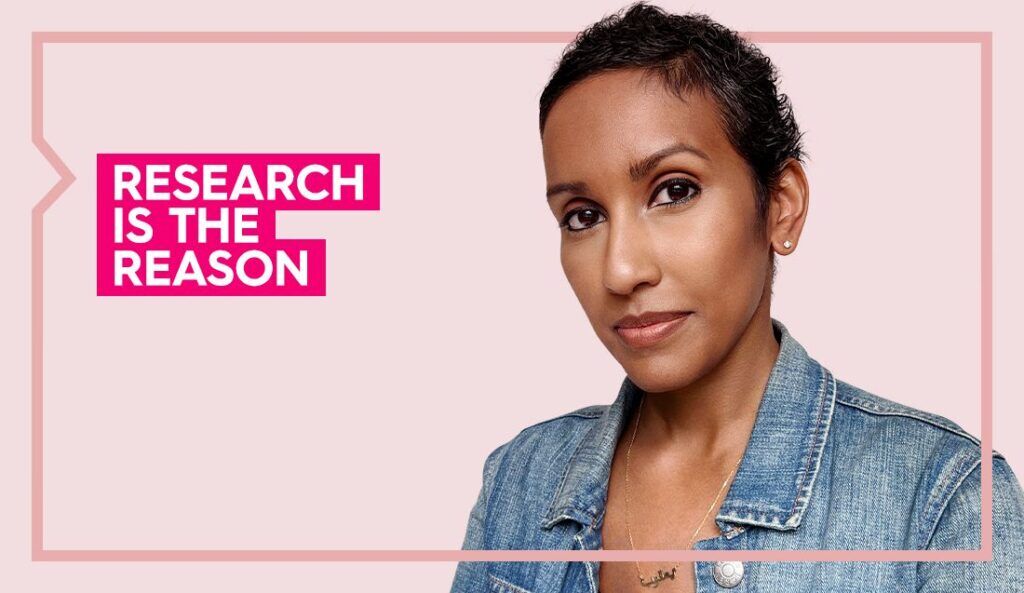BCRF staffer and mom Sadia Zapp knew she benefitted from research when she was diagnosed with breast cancer—and now she’s motivated to do even more to end the disease
Even though she was only about 10 years old, Sadia Zapp remembers when her then-25-year-old aunt was diagnosed with breast cancer. Her family didn’t talk about the disease openly, but Sadia knew her aunt was sick and can recall her aunt’s wig more than two decades later.
Her aunt’s diagnosis—and the fact that it was at such a young age—stayed with Sadia from then on.
“It made me vigilant,” she said. “Breast cancer was a very explicit fear going back to my childhood, and it was always in the back of my mind. I knew the risk factors and what to be aware of when it came to my body.”
That personal connection to breast cancer also inspired Sadia to make health the focus of her career in nonprofit communications and public relations. When she saw a job opening at BCRF, she jumped at the chance to apply.
“One of the reasons I wanted to work at BCRF was because of my family history and the fact that I always feared I’d be diagnosed with breast cancer,” she said. “There were a couple of causes I really cared about, and breast cancer was one of them.”
In 2022, seven years into working at BCRF, Sadia’s professional life and her personal life collided when that fear came true: At 36 years old, she was diagnosed with breast cancer.
For years, doctors dismissed Sadia’s request to start screening earlier. Providers said that she wasn’t high-risk because her aunt wasn’t a first-degree relative, and that other potential risk factors weren’t of major concern. In early 2022, after another conversation about her risk with a new doctor, Sadia underwent genetic testing, which found no known mutations like BRCA1 or BRCA2. It did however find “variances of unknown significance” of two other genes associated with breast cancer. But since the risk level of those genes was still unknown, her doctor didn’t take them into consideration.
“I got the negative results, and I didn’t think about it again,” she said. “That July, we were also uprooting our lives. We bought a house and moved. And while we were unpacking boxes, I noticed a lump.”
Four weeks later, Sadia had the lump looked at with a mammogram and ultrasound. As she walked down what felt like an endless hallway to the radiologist’s office, all she could think was: Please, please, please let this be nothing.
“The radiologist sat me down, took my hands, and said, ‘There’s a lot going on in that right breast. I believe this is cancer,’” Sadia remembered. “Even though I had always been afraid this would happen to me, I still just couldn’t believe it. I sat crying in her office for quite some time and didn’t have a kernel of hope when I left.”
After countless phone calls, Sadia quickly assembled her care team and underwent several biopsies and tests to finalize her treatment plan and start as soon as possible. She was ultimately diagnosed with hormone-positive, HER2-negative breast cancer, the most common form of the disease, which had spread to her lymph nodes. Over four months, she got eight rounds of chemotherapy and then had a double mastectomy followed by five weeks of radiation, and eventually reconstruction. After completing active treatment, she started hormone therapy along with a CDK4/6 inhibitor to reduce her risk of recurrence.
Knowing so much about breast cancer and the latest research was both a blessing and curse.
“When I was diagnosed, I didn’t have to Google anything,” she said. “But on the flip side, I knew all the stats. I knew the survival rates for regional breast cancer and that metastatic disease is on the rise in women aged 25 to 40. Those stats were what played on a loop in my head. I didn’t have an off switch.”
The hardest part of her diagnosis was confronting her mortality as a wife and a mom to her son, Jake, who was four at the time. Sadia made a point—no matter what was going on or how she was feeling—to read bedtime stories to her son every night.
“My son is all that matters,” she said. “This diagnosis brings all your fears to the forefront. Above all the treatment, the hardest thing was worrying that I might not be there for him.”
After years of being immersed in breast cancer research working at BCRF, Sadia said she knows that decades of science led to breakthroughs and treatments she benefitted from. BCRF investigators have had a hand in advancing all the therapies she will be on for at least five years.
“The treatment that saved my life and the drugs I am taking every day now to ensure my future have been made possible, in some way, by BCRF researchers—people whose work I help support every day, people I know or have worked with at some point over nearly a decade. I’ve never felt more grateful to our scientists.
“I’m here now and enjoying my son’s time in elementary school—thanks to research,” she said.
But because her own risk was overlooked for years, Sadia also sees more clearly how much more research is needed to close gaps in screening and risk assessment, improve outcomes for young women, and end metastatic disease. And she’s more motivated than ever to play a role in changing the course of breast cancer.
“There are four million breast cancer thrivers in the U.S., and I promise every single one of them has lain awake at night worrying about this disease,” she said. “Only research can end their fear.”






